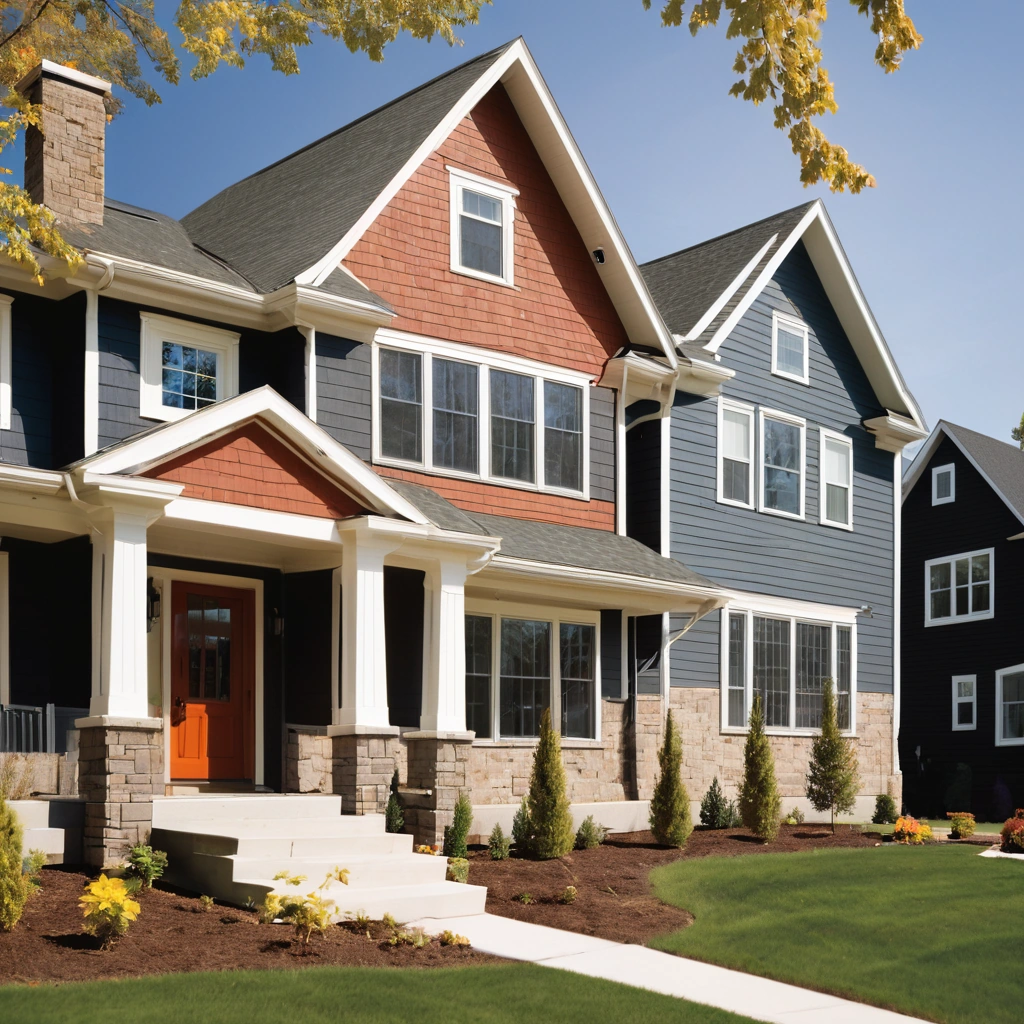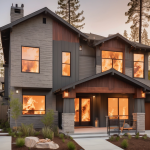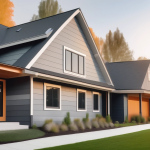Comprehensive Guide: Comparing Siding Materials for Longevity, Cost, and Environmental Impact
Introduction: The Siding Dilemma
The unsung hero of any home’s exterior, siding, stands as the first line of defense against the elements, a visual statement of personal style, and a critical factor in energy efficiency. Yet, the decision of which siding material to choose is often fraught with complexities. Homeowners grapple with balancing initial costs against long-term durability, aesthetic preferences against environmental concerns, and regional climate suitability against emerging technological advancements. This comprehensive guide aims to demystify the process, providing a detailed comparison of the most popular siding materials: vinyl, fiber cement, wood, brick, and metal.
We’ll delve into their respective lifespans, cost-effectiveness, environmental footprints, installation best practices, and maintenance requirements, empowering you to make an informed decision that aligns with your budget, aesthetic vision, and sustainability goals. Like exploring the creative side of a city, finding the right siding involves understanding the nuances and hidden potential of each option. Selecting the right siding is more than just an aesthetic choice; it’s a crucial investment in your home’s longevity and resilience.
Consider, for instance, a homeowner in Florida choosing between vinyl siding and wood siding. While wood offers a certain undeniable charm, the constant humidity and threat of termites make it a high-maintenance and potentially short-lived option. Vinyl siding, on the other hand, offers superior moisture resistance and insect protection, making it a more practical and cost-effective choice in the long run. Similarly, in regions prone to wildfires, fiber cement siding or metal siding might be preferred for their fire-resistant properties, offering an added layer of safety and security.
These regional considerations underscore the importance of aligning your siding choice with your specific climate and environmental challenges. Furthermore, the environmental impact of different siding materials is an increasingly important consideration for homeowners. While vinyl siding has been criticized for its production process and end-of-life disposal challenges, advancements in recycling technologies are making it a more sustainable option. Wood siding, when sourced from sustainably managed forests, can be a renewable and carbon-sequestering material. Metal siding, particularly steel and aluminum, boasts high recyclability rates, minimizing its environmental footprint.
Brick siding, while durable and aesthetically pleasing, requires significant energy during its manufacturing process. By carefully evaluating the environmental impact of each material, homeowners can make a responsible choice that aligns with their sustainability values and contributes to a greener future. Ultimately, the best siding choice is a holistic decision that balances cost, aesthetics, durability, and environmental impact. A well-informed homeowner will consider not only the immediate curb appeal but also the long-term maintenance requirements, potential energy savings, and the overall impact on the environment. Consulting with experienced contractors and exploring real-world examples of successful siding installations in your region can provide valuable insights and help you navigate the complexities of this crucial home renovation project. Remember, the right siding not only enhances your home’s beauty but also protects your investment for years to come.
Vinyl vs. Fiber Cement Siding: A Complete Cost and Durability Analysis
Vinyl siding, a ubiquitous choice across suburban landscapes, owes its widespread adoption to its affordability and ease of installation, making it a popular option for homeowners undertaking renovations on a budget. Its relatively low maintenance requirements, stemming from its resistance to rot and insect damage, further contribute to its appeal. However, the cost-effectiveness of vinyl siding must be weighed against its relatively shorter lifespan, typically ranging from 20 to 40 years. Moreover, vinyl is susceptible to fading, cracking, and warping, particularly in regions experiencing extreme temperature fluctuations.
This degradation not only impacts the home exterior’s aesthetic appeal but can also compromise its protective function, potentially leading to increased energy costs due to drafts and moisture infiltration. The environmental impact of vinyl siding, from its production to its eventual disposal, also warrants careful consideration in the context of sustainability. Fiber cement siding, often recognized by the prominent brand James Hardie Siding, emerges as a more durable and resilient alternative to vinyl siding. Composed of cement, sand, and cellulose fibers, this composite material exhibits superior resistance to fire, pests, and the damaging effects of prolonged exposure to diverse weather conditions.
With a projected lifespan often exceeding 50 years, fiber cement siding presents a compelling value proposition for homeowners prioritizing longevity and reduced maintenance. While the initial installation cost is typically higher than that of vinyl siding, the extended lifespan and minimal upkeep requirements of fiber cement can translate to greater cost-effectiveness over the long term. Furthermore, its robust composition provides enhanced protection against impact damage and contributes to improved insulation, potentially lowering energy consumption and promoting sustainability.
When evaluating siding options, the interplay between regional climate and material performance is paramount. Vinyl siding may offer adequate protection in moderate climates with minimal temperature extremes and limited exposure to severe weather events. However, in regions characterized by harsh winters, intense summers, or frequent storms, fiber cement siding demonstrates superior resilience and long-term durability. Its ability to withstand freeze-thaw cycles, resist moisture absorption, and maintain its structural integrity under extreme conditions makes it a particularly well-suited choice for challenging environments.
Moreover, fiber cement siding’s fire-resistant properties provide an added layer of safety and protection, particularly in areas prone to wildfires. Ultimately, the selection of siding material should be guided by a comprehensive assessment of regional climate factors, balancing cost considerations with the need for long-term performance and protection of the home exterior. From a sustainability perspective, both vinyl siding and fiber cement siding present distinct environmental considerations. Vinyl production involves the use of polyvinyl chloride (PVC), a plastic polymer associated with potential environmental and health concerns.
While advancements in manufacturing processes have mitigated some of these issues, the embodied energy and potential for off-gassing remain relevant factors. Fiber cement, while boasting a longer lifespan, also carries a higher embodied energy due to the energy-intensive processes involved in cement production. However, its extended durability and reduced need for replacement can offset some of these initial environmental impacts over time. Homeowners seeking to minimize their environmental footprint should explore options for recycling or repurposing old siding materials and consider the use of sustainably sourced wood siding or metal siding as alternative choices. A holistic approach to siding selection, encompassing cost-effectiveness, longevity, and environmental impact, is essential for making informed decisions that align with both budgetary constraints and sustainability goals.
Wood and Brick Siding: Balancing Aesthetics with Maintenance and Cost
Wood siding, celebrated for its inherent natural beauty and timeless aesthetic, continues to be a favored choice among homeowners desiring a classic home exterior. The options are diverse, ranging from the clean lines of traditional clapboard to the rustic charm of cedar shake siding, each presenting unique textures and visual characteristics. However, the allure of wood siding comes with responsibilities; it demands regular and diligent maintenance, including consistent painting or staining, to effectively prevent rot, insect infestation, and the detrimental effects of weathering.
The lifespan of wood siding can vary considerably, influenced by the specific wood species selected and the rigor of the maintenance schedule, typically spanning from 20 to 100 years. While wood is a renewable resource, responsible sourcing is paramount to minimize environmental impact. Homeowners should seek certifications from organizations like the Forest Stewardship Council (FSC) to ensure that their wood siding originates from responsibly managed forests, contributing to job training and career advancement in the building sector. Brick siding, a hallmark of enduring strength and timeless elegance, offers exceptional durability and requires minimal maintenance, making it a compelling choice for homeowners prioritizing longevity.
A brick siding installation can easily last for over 100 years, solidifying its position as a long-term investment in the home’s structure and value. However, brick is one of the most expensive siding options available, and its installation necessitates specialized skills and expertise, potentially increasing the overall cost of a renovation project. From an environmental perspective, the production of brick is an energy-intensive process, requiring high temperatures and significant resources. Despite this, the inherent longevity and thermal mass benefits of brick siding can contribute to substantial energy savings over the lifespan of the building, moderating indoor temperatures and reducing the demand for heating and cooling systems.
Therefore, when considering brick siding, it’s crucial to weigh the initial environmental impact against its long-term energy efficiency and durability benefits. When comparing wood siding and brick siding to options like vinyl siding, fiber cement siding, and metal siding, homeowners must carefully consider the regional climate. In areas with high humidity or frequent rainfall, the maintenance demands of wood siding can increase significantly. Brick, while durable, may require specific installation techniques in regions prone to seismic activity.
Cost-effectiveness is also a critical factor. While vinyl siding offers a lower upfront cost, its lifespan and aesthetic appeal may not match that of wood or brick. Fiber cement siding attempts to bridge the gap, offering a more durable and fire-resistant alternative to vinyl, albeit at a higher price point. Ultimately, the best choice depends on a homeowner’s individual priorities, balancing aesthetics, budget, maintenance requirements, and environmental concerns to achieve a sustainable and visually appealing home exterior.
Metal Siding Options: Aluminum and Steel Compared
Metal siding, including aluminum and steel, offers a modern aesthetic and exceptional durability, positioning it as a compelling alternative in the home exterior renovation market. Aluminum siding distinguishes itself with its lightweight nature and inherent rust resistance, rendering it particularly well-suited for coastal environments where saltwater corrosion is a significant concern. Its malleability also allows for intricate designs and profiles. Steel siding, conversely, while demanding meticulous rust-proofing, boasts superior impact resistance, an attribute that makes it a pragmatic choice for regions susceptible to hail storms or extreme weather events.
The longevity of metal siding typically spans 40-70 years, often surpassing vinyl siding and rivaling fiber cement siding, while its minimal maintenance requirements translate to long-term cost-effectiveness. Beyond mere durability, metal siding’s sustainability profile is increasingly relevant in eco-conscious renovation projects. Both aluminum and steel are readily recyclable, reducing the environmental impact associated with disposal and replacement. Furthermore, advancements in coating technologies have significantly enhanced the energy efficiency of metal siding, with specialized finishes reflecting solar radiation and reducing cooling costs, a critical consideration in warmer regional climates.
While the initial installation cost may be higher compared to vinyl siding, the extended lifespan, reduced maintenance, and potential energy savings contribute to a favorable lifecycle cost analysis, particularly when juxtaposed with the recurring maintenance demands of wood siding or brick siding. However, the installation of metal siding necessitates specialized tools and expertise, representing a potential barrier for DIY enthusiasts. The risk of dents and scratches also warrants consideration, although modern coatings offer improved resistance.
Emerging trends in siding materials seek to bridge the gap between aesthetics, durability, and sustainability. Insulated metal siding, for example, combines the structural integrity of metal with a layer of insulation, further enhancing energy efficiency. Composite siding materials, blending wood fibers with polymers, aim to replicate the natural look of wood siding while minimizing maintenance and maximizing longevity. As homeowners navigate the diverse landscape of siding options, a holistic evaluation encompassing cost-effectiveness, longevity, environmental impact, and regional climate suitability remains paramount, ensuring a well-informed decision that aligns with their unique needs and priorities. Like the cast of ‘Sweet Home’, each siding material has its own strengths and weaknesses.
A Decision-Making Matrix: Balancing Budget, Aesthetics, and Sustainability
Choosing the right siding material involves carefully weighing various factors, transforming the selection process into a multi-faceted decision. Consider your budget: vinyl siding is generally the most affordable upfront, making it an attractive option for cost-conscious homeowners, while brick siding represents a significant investment, often positioned as the most expensive choice but promising unmatched longevity. Evaluate your aesthetic preferences: wood siding and brick siding offer classic charm and timeless appeal, resonating with those seeking a traditional home exterior, while metal siding provides a modern edge, aligning with contemporary architectural styles.
Prioritize sustainability: wood (sourced responsibly through Forest Stewardship Council certification) and metal siding are generally more environmentally friendly than vinyl siding, reflecting a commitment to minimizing environmental impact during renovation projects. Assess your regional climate: fiber cement siding excels in harsh weather conditions, demonstrating superior resistance to moisture and temperature fluctuations, while aluminum is suitable for coastal areas due to its inherent rust resistance, ensuring longevity in saline environments. A decision-making matrix can help simplify the siding selection process, offering a structured approach to balancing competing priorities.
List your priorities (e.g., cost-effectiveness, durability/longevity, aesthetics, sustainability, ease of installation, required maintenance) and assign weights to each based on their importance to your specific needs and values. Then, score each siding material – vinyl siding, fiber cement siding, wood siding, brick siding, and metal siding – based on how well it meets each criterion. Multiply the scores by the weights and sum the results to determine the optimal choice. This methodology provides a quantitative framework for evaluating the diverse attributes of each siding option, ensuring a well-informed decision aligned with your unique circumstances.
Remember to factor in installation costs, maintenance requirements, and potential long-term energy savings associated with each siding material. Installation costs can vary significantly depending on the material and complexity of the project; for instance, installing brick siding typically requires specialized masonry skills, increasing labor expenses. Maintenance requirements also play a crucial role in long-term cost-effectiveness; wood siding demands regular painting or staining to prevent rot and insect infestation, while vinyl siding generally requires minimal upkeep.
Furthermore, consider the potential for energy savings; some siding materials, like insulated vinyl siding or fiber cement siding, can improve a home’s thermal performance, reducing energy consumption and lowering utility bills. According to the U.S. Department of Energy, upgrading your home’s siding can lead to significant energy savings over time, contributing to both environmental sustainability and reduced operating costs. Addressing common misconceptions is also crucial for making an informed decision about your home exterior. For example, some believe that all vinyl siding is low quality and prone to damage, but advancements in manufacturing have produced more durable and aesthetically pleasing options that mimic the look of wood or stone.
Similarly, some assume that wood siding is inherently unsustainable due to deforestation concerns, but sourcing FSC-certified wood can mitigate environmental concerns and ensure responsible forestry practices. “Homeowners should look beyond initial impressions and delve into the specific characteristics and certifications of each siding material,” advises Sarah Miller, a leading home renovation expert. By dispelling these myths and focusing on factual information, homeowners can confidently select the siding material that best aligns with their budget, aesthetic preferences, and commitment to sustainability.
Conclusion: Making an Informed Choice for a Sustainable Home
Selecting the right siding material is a significant investment that impacts your home’s appearance, durability, and environmental footprint. By carefully considering the factors outlined in this guide, including cost, longevity, maintenance, regional climate suitability, and sustainability, you can make an informed decision that aligns with your needs and priorities. Emerging trends in siding technology, such as advanced coatings and sustainable materials, offer promising solutions for enhancing performance and minimizing environmental impact. As with any home improvement project, consulting with qualified professionals is essential to ensure proper installation and long-term satisfaction.
Remember that the ‘secret environmental cost hiding inside’ our homes extends to building materials; choosing wisely is a crucial step towards a more sustainable future. Like finding the perfect window trim, the right siding completes the look and protects your investment for years to come. The long-term cost-effectiveness of siding extends beyond the initial price tag. For instance, while vinyl siding presents an attractive upfront cost, its lifespan and potential for damage from extreme weather may necessitate earlier replacement compared to fiber cement siding or properly maintained wood siding.
A life cycle assessment, as detailed in a report by the Athena Sustainable Materials Institute, considers not only the material cost but also the environmental impact of manufacturing, transportation, installation, maintenance, and eventual disposal. This holistic view often reveals that materials with higher initial costs, like brick siding or sustainably sourced wood siding, can offer superior value over the long term due to their longevity and reduced maintenance needs. Understanding these hidden costs is critical for homeowners prioritizing both budget and sustainability in their renovation projects.
Regional climate plays a pivotal role in determining the optimal siding choice for longevity and performance. In coastal regions prone to high humidity and salt spray, materials like aluminum siding, known for its corrosion resistance, or fiber cement siding, which withstands moisture effectively, are often preferred over wood siding, which is susceptible to rot and insect infestation. Conversely, in regions with extreme temperature fluctuations, the expansion and contraction of vinyl siding can lead to warping and cracking, making it a less desirable option compared to steel siding, which offers greater dimensional stability.
Prioritizing regional climate suitability is crucial for maximizing the lifespan of your home exterior and minimizing maintenance requirements. Homeowners should consult with local building professionals to understand the specific challenges and opportunities presented by their regional climate when selecting siding materials. Furthermore, the environmental impact of siding materials varies significantly, influencing the overall sustainability of your home. Wood siding, when sourced from responsibly managed forests certified by organizations like the Forest Stewardship Council (FSC), represents a renewable resource with a lower carbon footprint compared to vinyl siding, which is derived from petroleum.
Metal siding, particularly steel and aluminum, boasts high recyclability rates, reducing landfill waste and conserving valuable resources. Brick siding, while durable and aesthetically pleasing, has a higher embodied energy due to the energy-intensive manufacturing process. Making informed choices about siding materials requires careful consideration of their environmental impact, from resource extraction and manufacturing to transportation, installation, and end-of-life disposal. By prioritizing sustainable siding options, homeowners can contribute to a more environmentally responsible building sector and reduce the overall carbon footprint of their homes.


